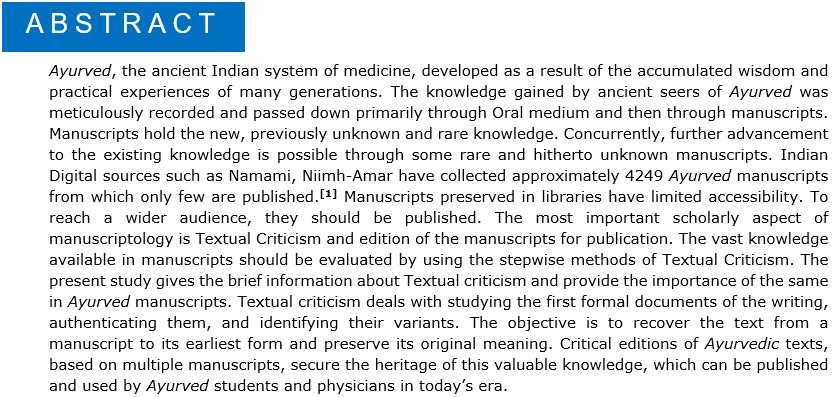Review on importance of Textual Criticism in Ayurveda Manuscriptology
DOI:
https://doi.org/10.21760/jaims.9.5.16Keywords:
Manuscriptology, Ayurveda, Namami, Niimh-Amar, Indian Digital sources, Textual criticismAbstract
Ayurved, the ancient Indian system of medicine, developed as a result of the accumulated wisdom and practical experiences of many generations. The knowledge gained by ancient seers of Ayurved was meticulously recorded and passed down primarily through Oral medium and then through manuscripts. Manuscripts hold the new, previously unknown and rare knowledge. Concurrently, further advancement to the existing knowledge is possible through some rare and hitherto unknown manuscripts. Indian Digital sources such as Namami, Niimh-Amar have collected approximately 4249 Ayurved manuscripts from which only few are published.[1] Manuscripts preserved in libraries have limited accessibility. To reach a wider audience, they should be published. The most important scholarly aspect of manuscriptology is Textual Criticism and edition of the manuscripts for publication. The vast knowledge available in manuscripts should be evaluated by using the stepwise methods of Textual Criticism. The present study gives the brief information about Textual criticism and provide the importance of the same in Ayurved manuscripts. Textual criticism deals with studying the first formal documents of the writing, authenticating them, and identifying their variants. The objective is to recover the text from a manuscript to its earliest form and preserve its original meaning. Critical editions of Ayurvedic texts, based on multiple manuscripts, secure the heritage of this valuable knowledge, which can be published and used by Ayurved students and physicians in today’s era.
Downloads
References
niimh.nic.in (AMAR- AYUSH Manuscripts Advanced Repository)
G, S. K., Mund, J., Nambootiri, V., & Nair, L. P. (2016). Manuscriptology: Relevance for Ayurveda Research Scholar. International Journal of Ayurvedic Medicine, 7(1). https://doi.org/10.47552/ijam.v7i1.802
https://www.namami.gov.in (National Mission for Manuscripts)
Manuscript and Textual Criticism, University of Calicut, Dr. Sooraj R.S.
Anjana R S, Resmi B. A Review on Critical Edition of Ayurveda Manuscripts. International Journal of Ayurveda and Pharma Research. 2022;10(2):58-63. https://doi.org/10.47070/ijapr.v10i2.2281
Aswathy P B et al: A Review on Textual Criticism in Ayurveda. International Ayurvedic
Medical Journal {online} 2024 {cited March 2024}
A Review on Critical Edition of Ayurveda Manuscripts, Anjana R.S, Resmi B http://www.iamj.in/posts/images/upload/569_572.pdf
Sreelekha KG, Deterioration of Manuscripts, Journal of Manuscript Studies, Published by Oriental Research institute and Manuscript Library, University of Kerala, Karyavattom, Thiruanathapuram, Vol. XXXIX- 2009-10p 20-31.















